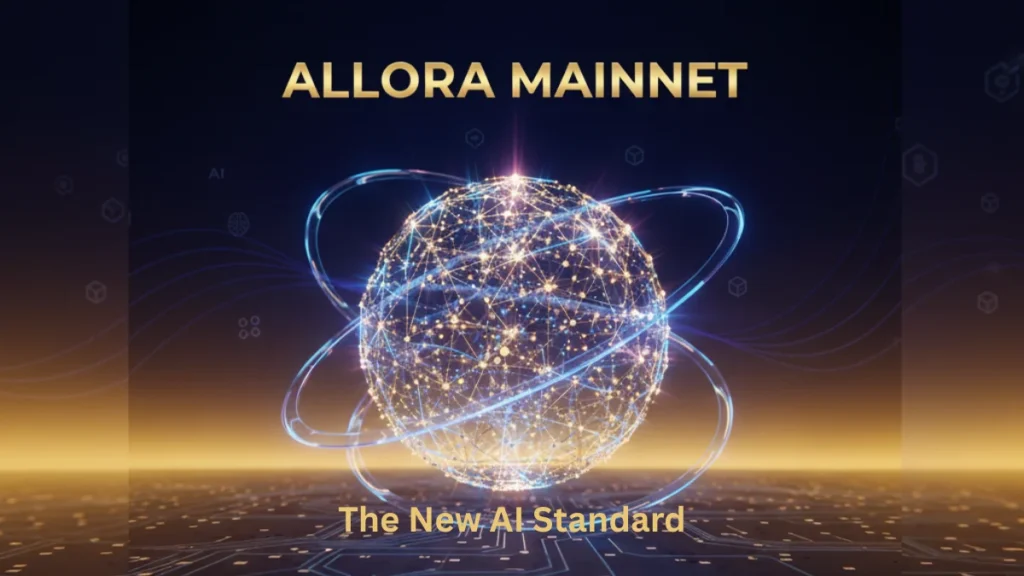The future of AI won’t be built by one model — it will be collective.
This week, Allora revealed its long-awaited Mainnet launch, positioning itself as the first decentralized intelligence layer where developers, agents, and applications can tap into collective inference instead of siloed models. The move marks the start of what its creators call the “new AI standard.”
Key Takeaways
- Allora Mainnet introduces objective-centric, decentralized intelligence.
- ALLO token launches as the first intelligence-backed digital asset.
- Staking and Allora Prime program drive early network adoption.
- Developers gain access to predictive feeds, SDKs, and ML tooling.
- Bridges make ALLO available across chains from day one.
Allora Mainnet is the first decentralized intelligence layer, shifting AI from model-centric to objective-centric design. At launch, developers, builders, and users gain access to predictive feeds, staking, and ALLO tokens — positioning Allora as a collective AI network that grows stronger with participation.
A Collective Future for AI
AI has always been about smarter models. Allora flips that idea on its head. Instead of developers choosing which model to run, the network lets them specify what they want to achieve. From there, collective inference across multiple contributors delivers a stronger, more adaptive output. With its Mainnet now rolling out globally, Allora is betting big on “objective-centric” AI as the new standard.
What Goes Live on Day One
The Mainnet launch isn’t just symbolic — it’s fully functional. From the first block, users will see predictive feeds for price and log returns migrate from testnet to production. Contributors who’ve already proven themselves in Allora Playground and Forge will carry over their reputations, securing a spot in the new network.
Autonomous agents will also gain access to live predictive signals, allowing them to assist in decision-making across markets, finance, and even decentralized applications. Validators and reputers will anchor trust, while staking mechanics keep incentives aligned.
Perhaps most importantly, bridges ensure ALLO — the network’s native token — is usable across multiple ecosystems from day one.
ALLO: The First Intelligence-Backed Asset
At the heart of Allora’s economy lies ALLO, a token designed to scale with intelligence itself. Unlike conventional crypto assets tied to a single chain or project, ALLO represents exposure to the entire network’s collective intelligence.
That means holders aren’t betting on a single AI model or team. Instead, their stake reflects the aggregated strength of thousands of contributors — from data scientists to autonomous agents. For early adopters, it’s a bold proposition: ALLO isn’t just digital money, it’s a claim on the growth of AI’s intelligence economy.
Staking and Allora Prime
Security and trust are critical to any decentralized system. Allora addresses this with ALLO staking. Validators and reputers are incentivized to keep inference quality high, while delegators earn rewards by supporting them.
A special program, Allora Prime, boosts rewards for early participants, aiming to bootstrap strong economic security from launch. While details remain limited, the Prime initiative appears designed to reward the community’s earliest risk-takers.
Bridges and Multi-Chain Reach
On day one, ALLO will be available across EVM-compatible chains and bridgeable into the Allora chain. That flexibility makes it easier for developers to integrate intelligence feeds into DeFi, prediction markets, and AI-driven strategies without worrying about fragmentation. More bridges are already planned, signaling that cross-chain access will be a cornerstone of Allora’s adoption strategy.
Why It Matters for Builders
For developers, Allora Mainnet offers more than infrastructure — it’s a canvas. Builders can integrate predictive signals, deploy agents, and experiment with new forms of intelligence coordination.
Workers on Playground and Forge topics will see their contributions recognized at launch, while upcoming tools like Forge 2.0 and enhanced ML SDKs promise smoother integration. New predictive feeds, including real-world assets and event probabilities, are also on the roadmap.
The clear takeaway: Mainnet is just the beginning. Allora is setting the stage for a broader ecosystem of decentralized AI applications.
Global Implications
Allora positions itself not only as another blockchain project but as the intelligence layer of the AI stack. That framing matters. By democratizing access to high-quality inferences, the network could reshape how businesses, researchers, and autonomous agents interact with AI.
In an era where proprietary AI models dominate headlines, Allora offers a counterpoint: collective intelligence that improves as more participants join. The project’s success will depend on adoption — but if traction grows, it may redefine what “open AI” truly means in practice.
What Happens Next
The team has already outlined an educational push leading up to launch. Upcoming explainers will cover staking, validator responsibilities, and bridging. A technical roadmap promises new topic diversification and enhanced tooling, keeping builders engaged well past launch week.
For the broader AI and crypto community, Allora’s debut offers both a challenge and an opportunity. Can decentralized networks deliver better intelligence than corporate labs? That’s the experiment Allora is inviting the world to join.
Conclusion
Allora Mainnet isn’t just another blockchain going live. It’s a bet that collective intelligence — coordinated through incentives and open participation — can outpace centralized AI models. With ALLO at its core, the network could become the first true intelligence economy, reshaping how humans and machines collaborate in the years ahead.
